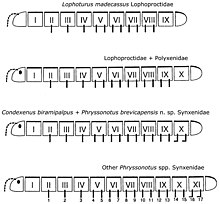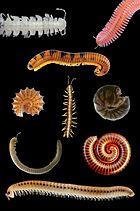| Polyxenida Temporal range: Barremian–Present PreꞒ Ꞓ O S D C P T J K Pg N | |
|---|---|

| |
| Polyxenus lagurus | |
| Scientific classification | |
| Domain: | Eukaryota |
| Kingdom: | Animalia |
| Phylum: | Arthropoda |
| Subphylum: | Myriapoda |
| Class: | Diplopoda |
| Subclass: | Penicillata Latrielle, 1831 |
| Order: | Polyxenida Verhoeff, 1934 |
| Families | |
| Synonyms | |
|
Subclass | |

Lophoturus madecassus
Other Lophoproctidae and Polyxenidae
Condexenus biramipalpus and Phryssonotus brevicapensis
Other Phryssonotus
Polyxenida is an order of millipedes readily distinguished by a unique body plan consisting of a soft, non-calcified body ornamented with tufts of bristles. These features have inspired the common names bristly millipedes or pincushion millipedes. This order includes about 148 species in four families worldwide, which represent the only living members of the subclass Penicillata.
Description
Polyxenida differ from other millipedes in having a soft, non-calcified exoskeleton, unique tufts of bristles or setae, fewer legs (no more than 17 pairs), and an absence of copulatory appendages in males. Individuals are small, usually 1.5 to 4 millimeters (0.06 to 0.16 inches) long and not exceeding 7 millimeters (0.28 inches) long. Adults in most species have 13 pairs of legs, but in one species (Lophoturus madecassus), they have only 11 pairs of legs, and in one genus (Phryssonotus), they have 17 pairs of legs, except for one species (Phryssonotus brevicapensis) in which they (along with those in one other species, Condexenus biramipalpus) have 15 pairs of legs.
Defense
Bristly millipedes lack the chemical defenses and hard exoskeleton of other millipedes. Instead, these millipedes employ a unique defense mechanism: Bristles at the rear end of these millipedes feature hooks and barbs. These distinctive barbed bristles can easily detach and become entangled in the limbs and mouth-parts of predatory insects, effectively immobilizing them.
Reproduction
Male Polyxenidans lack the modified sperm-transferring appendages (gonopods) found in most other millipede groups. Instead, sperm transfer is indirect: Males deposit spermatophores into webs that they construct. Females then find these spermatophores by following threads spun by the males and pick up the spermatophores with their genitalia.
At least two species reproduce asexually by way of parthenogenesis, wherein females lay eggs without mating and males are absent or rare. For example, studies of the common species Polyxenus lagurus have found males scarce or absent in parts of northeastern Europe. Authorities suspect that in these populations, this species reproduces by thelytoky, that is, parthenogenisis in which unfertilized females produce female offspring.
Development
Millipedes in this order grow and develop through a series of molts, adding segments and legs until they reach a fixed number in the adult stage, which is the same in a given species. Adults continue to molt, but they do not add segments or legs. This mode of development is known as hemianamorphosis.
The typical pattern in this order is observed in the common species Polyxenus lagurus. In this species, millipedes hatch with only 3 pairs of legs and 4 tergites, then develop through a series of seven molts and emerge as adults with 13 leg pairs and 10 tergites in the eighth stage. In this process, this millipede goes through stages with 3, 4, 5, 6, 8, 10, 12, and 13 leg pairs. Species in which adults have a different number of legs deviate from this common pattern.
Classification

Polyxenida is the only living order of the subclass Penicillata, the basal subclass of millipedes. Penicillata is the sister group of all other living millipedes, which form the subclass Chilognatha. The subclass Chilognatha contains the infraclasses Pentazonia and Helminthomorpha.
In 2003, the order Polyxenida contained 159 valid species and/or subspecies. At least eight new species have been described since 2010.
- Superfamily Polyxenoidea Lucas, 1840
- Hypogexenidae Schubart, 1947
- Lophoproctidae Silvestri, 1897
- Polyxenidae Lucas, 1840
- Superfamily Synxenoidea Silvestri, 1923
- Synxenidae Silvestri, 1923
Fossil history
The earliest representatives of Polyxenida are found in Lebanese amber from the Early Cretaceous period. The fossil records also include representatives found in Burmese amber, Baltic amber, and the Cretaceous amber of Haute-Provence in France. These fossils indicate that the families Polyxenidae and Synxenidae already existed in the Cretaceous period.
Some authors place the extinct orders Arthropleurida and Eoarthropleurida (each represented by a single genus) within the Penicillata as a sister group to Polyxenida. Others consider these extinct orders to be a sister group to Penicillata. Still others deem these extinct orders to be a sister group to the subclass Chilognatha instead.
References
- Henen, Derek; Brown, Jeff. Millipedes of Ohio (PDF). Ohio Division of Wildlife. pp. 3, 16–17.
- "Order Polyxenida - Bristly Millipedes". bugguide.net. Retrieved 2024-07-23.
- ^ Enghoff, Henrik; Golovatch, Sergei; Short, Megan; Stoev, Pavel; Wesener, Thomas (2015-01-01). "Diplopoda — taxonomic overview". Treatise on Zoology - Anatomy, Taxonomy, Biology. The Myriapoda, Volume 2: 363–453. doi:10.1163/9789004188273_017.
- ^ Nguyen Duy-Jacquemin, M.; J.-J. Geoffroy (2003). "A revised comprehensive checklist, relational database, and taxonomic system of reference for the bristly millipedes of the world (Diplopoda, Polyxenida)". African Invertebrates. 44 (1): 89–101.
- ^ Blower, J. Gordon (1985). Millipedes : keys and notes for the identification of the species. Linnean Society of London, Estuarine and Brackish-water Sciences Association. London: Published for the Linnean Society of London and the Estuarine and Brackish-Water Sciences Association by E.J. Brill. ISBN 90-04-07698-0. OCLC 13439686.
- ^ Nguyen Duy - Jacquemin, Monique; Uys, Charmaine; Geoffroy, Jean-Jacques (2011). "Two remarkable new species of Penicillata (Diplopoda, Polyxenida) from Table Mountain National Park (Cape Town, South Africa)". ZooKeys (156): 85–103. doi:10.3897/zookeys.156.2211. PMC 3253573. PMID 22303097.
- Shelley, Rowland M. "The Myriapoda (Millipedes, Centipedes) Featuring the North American Fauna". Archived from the original on 30 October 2013. Retrieved 30 October 2013.
- Eisner, T; Eisner, M; Deyrup, M (1996). "Millipede defense: use of detachable bristles to entangle ants". Proceedings of the National Academy of Sciences of the United States of America. 93 (20): 10848–51. Bibcode:1996PNAS...9310848E. doi:10.1073/pnas.93.20.10848. PMC 38244. PMID 8855269.
- Shelley, Rowland M. (1999). "Centipedes and Millipedes with Emphasis on North American Fauna". The Kansas School Naturalist. 45 (3): 1–16. Archived from the original on 2016-11-12. Retrieved 2013-10-12.
- Barnes, Robert D. (1987). "15. The myriapods". Invertebrate zoology (5th ed.). Philadelphia: Saunders College Pub. pp. 674–683.
- Enghoff, Henrik (1976). "Morphological comparison of bisexual and parthenogenetic Polyxenus lagurus (Linne, 1758) (Diplopoda Polyxenidae) in Denmark and Southern Sweden, with notes on taxonomy, distribution and ecology" (PDF). Entomologiske Meddelelser. 44: 161–182.
- ^ Enghoff, Henrik; Dohle, Wolfgang; Blower, J. Gordon (1993). "Anamorphosis in Millipedes (Diplopoda) — The Present State of Knowledge with Some Developmental and Phylogenetic Considerations". Zoological Journal of the Linnean Society. 109 (2): 103–234. doi:10.1111/j.1096-3642.1993.tb00305.x.
- Sierwald, Petra; Bond, Jason E. (2007). "Current Status of the Myriapod Class Diplopoda (Millipedes): Taxonomic Diversity and Phylogeny". Annual Review of Entomology. 52 (1): 401–420. doi:10.1146/annurev.ento.52.111805.090210. PMID 17163800.
- Shear, W (2011). "Class Diplopoda de Blainville in Gervais, 1844. In: Zhang, Z.-Q.(ed.) Animal biodiversity : an outline of higher-level classification and survey of taxonomic richness" (PDF). Zootaxa. 3148: 159–164. doi:10.11646/zootaxa.3148.1.32.
- Short, Megan; Huynh, Cuong (2011). "The genus Unixenus Jones, 1944 (Diplopoda, Penicillata, Polyxenida) in Australia". ZooKeys (156): 105–122. doi:10.3897/zookeys.156.2168. PMC 3253574. PMID 22303098.
- Short, Megan; Huynh, Cuong (2013). "Four new species of Unixenus Jones, 1944 (Diplopoda, Penicillata, Polyxenida) from Australia". ZooKeys (278): 75–90. doi:10.3897/zookeys.278.4765. PMC 3677348. PMID 23794829.
- Duy-Jacquemin, MN; Azar, D (2004). "The oldest records of Polyxenida (Myriapoda, Diplopoda): New discoveries from the Cretaceous ambers of Lebanon and France". Geodiversitas. 26 (4): 631–641.
- Kraus, O; C. Brauckman (2003). "Fossil giants and surviving dwarfs. Arthropleurida and Pselaphognatha (Ateolocerata, Diplopoda): characters, phylogenetic relationships and construction". Verh. Naturwiss. Ver. Hamburg. 40 (5): 5–50.
- Shear, William A.; Edgecombe, Gregory D. (2010). "The geological record and phylogeny of the Myriapoda". Arthropod Structure & Development. 39 (2–3): 174–190. doi:10.1016/j.asd.2009.11.002. PMID 19944188.
External links
 Media related to Polyxenida at Wikimedia Commons
Media related to Polyxenida at Wikimedia Commons Data related to Polyxenida at Wikispecies
Data related to Polyxenida at Wikispecies- "Polyxenida". The Encyclopedia of Life.

- Photos of Polyxenida
| Orders of the class Diplopoda (millipedes) | |||||||||||||||||||||||||||||||||
|---|---|---|---|---|---|---|---|---|---|---|---|---|---|---|---|---|---|---|---|---|---|---|---|---|---|---|---|---|---|---|---|---|---|
| |||||||||||||||||||||||||||||||||
| |||||||||||||||||||||||||||||||||
| |||||||||||||||||||||||||||||||||

